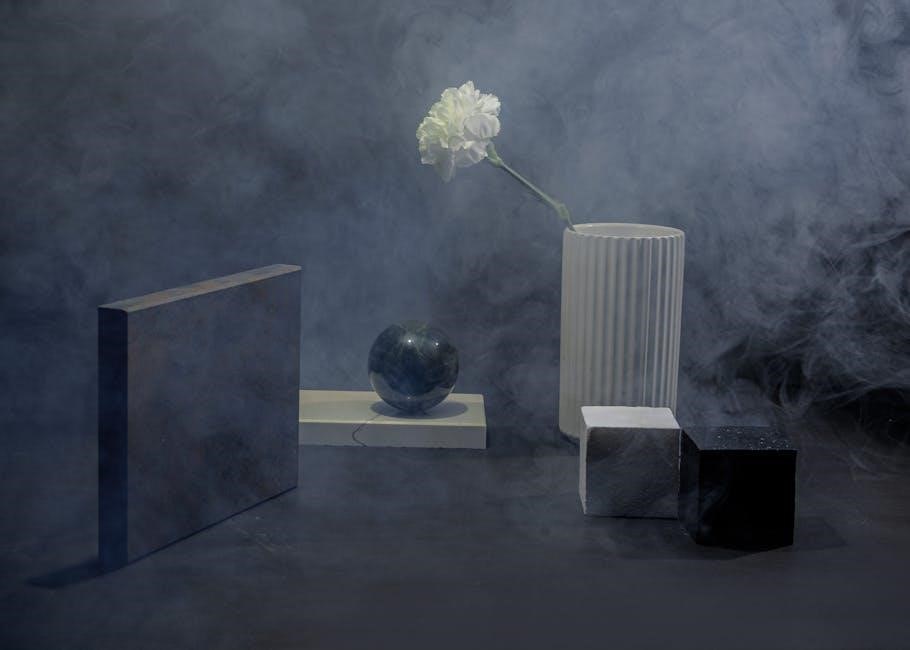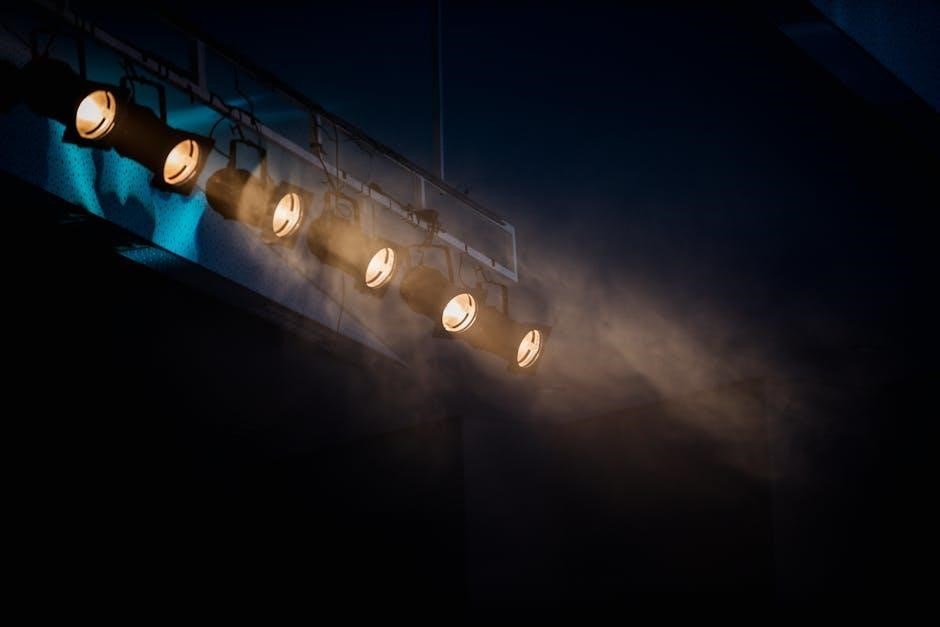A smoke detector installation guide PDF provides essential steps and best practices for ensuring your home is equipped with reliable fire safety devices. Proper installation and maintenance are critical for protecting lives and property. This guide offers comprehensive instructions‚ covering everything from choosing the right detector to troubleshooting common issues‚ ensuring your smoke detectors function optimally. Whether you’re a homeowner or a professional‚ this resource is your go-to for safe and effective smoke detector setup.
Importance of Smoke Detectors
Smoke detectors are crucial for early fire detection‚ providing life-saving alerts during emergencies. They minimize risks by signaling the presence of smoke before it spreads‚ allowing timely evacuation. Properly installed smoke detectors significantly reduce fire-related injuries and fatalities. Their effectiveness depends on correct placement‚ maintenance‚ and type‚ ensuring they operate reliably in various environments. High ceilings‚ complex layouts‚ and areas like kitchens require special consideration to avoid false alarms. Regular testing and maintenance are vital to ensure functionality. Smoke detectors act as a first line of defense‚ offering peace of mind and protecting property. Their importance cannot be overstated‚ as they are essential for safeguarding lives and assets in both residential and commercial settings.
Overview of Smoke Detector Installation
Smoke detector installation involves several key steps to ensure optimal functionality and safety. Proper placement is critical‚ with detectors typically installed near the ceiling to maximize smoke detection. High ceilings require careful consideration to ensure smoke reaches the sensor. Avoid areas near bathrooms‚ ceiling fans‚ and cooking appliances to minimize false alarms. The installation process includes mounting the bracket‚ attaching the detector‚ and connecting power sources‚ whether battery-operated or hardwired. Wireless models offer flexibility‚ while hardwired systems provide reliability. Costs range from $50 to $300 per detector‚ depending on type and complexity. Regular testing and maintenance are essential to ensure reliability. Hiring a professional is recommended for complex setups. Proper installation and adherence to local codes are vital for effective fire safety. This guide provides detailed steps to help you install smoke detectors correctly and maintain them for long-term protection.

Types of Smoke Detectors
Smoke detectors come in various types‚ including battery-operated‚ hardwired‚ and wireless models‚ each offering unique advantages for different installation scenarios and connectivity needs.
Battery-Operated Smoke Detectors
Battery-operated smoke detectors are a cost-effective and easy-to-install option‚ ideal for homes without existing wiring. They are portable and can be placed in various locations‚ ensuring flexibility. These detectors rely on replaceable or non-replaceable batteries‚ often featuring low-battery indicators to remind users of replacements. Installation typically involves mounting a bracket and securing the detector‚ often with a simple twist or snap mechanism. Testing is crucial after installation to ensure proper functionality. They are widely used in residential settings due to their simplicity and affordability‚ making them a popular choice for homeowners seeking reliable fire safety without complex setups.

Hardwired Smoke Detectors
Hardwired smoke detectors are connected directly to your home’s electrical system‚ providing a reliable power source. They are highly recommended for their consistent performance and are less prone to tampering. These detectors are typically interconnected‚ meaning if one alarms‚ all units in the system will sound‚ enhancing safety. Installation requires professional expertise‚ as it involves wiring and ensuring compliance with local building codes. Many models include a battery backup for continued operation during power outages. Hardwired detectors are ideal for long-term reliability and are often preferred in new constructions or extensive renovations. Proper installation and regular testing are essential to ensure they function correctly in case of emergencies.
Wireless Smoke Detectors
Wireless smoke detectors offer flexibility and convenience‚ eliminating the need for complex wiring. They use radio frequencies or Wi-Fi to interconnect with other detectors‚ ensuring seamless communication. These detectors are ideal for retrofitting older homes or for installations where running wires is challenging. Wireless models often include battery operation‚ reducing dependency on hardwired power. However‚ they require consistent battery monitoring to ensure reliability. Many modern wireless smoke detectors integrate with smart home systems‚ allowing remote monitoring and notifications via smartphones. Installation is generally simpler compared to hardwired systems‚ but proper placement and alignment are crucial to avoid interference from other devices. Wireless smoke detectors provide a modern‚ efficient solution for comprehensive fire safety coverage.
Ionization vs. Photoelectric Smoke Detectors
Ionization smoke detectors use a small radioactive source to ionize air molecules‚ creating a current. When smoke disrupts this current‚ the alarm triggers. These detectors excel at detecting fast-flaming fires with minimal visible smoke. Photoelectric detectors‚ on the other hand‚ use a light source. When smoke particles scatter light‚ it triggers the alarm. These are better at detecting smoldering fires‚ producing thick smoke. Choosing the right type depends on fire risks in specific areas. Ionization detectors are cost-effective and responsive‚ while photoelectric models reduce false alarms from cooking or steam. Dual-sensor detectors combine both technologies‚ offering comprehensive protection against various fire scenarios. Understanding these differences helps in selecting the most suitable detector for different rooms and fire hazards.
Dual-Sensor Smoke Detectors
Dual-sensor smoke detectors combine ionization and photoelectric technologies‚ offering enhanced fire detection capabilities. By integrating both sensors‚ these detectors effectively respond to a broader range of fire conditions‚ including fast-flaming and smoldering fires. Ionization sensors detect small smoke particles from rapid fires‚ while photoelectric sensors identify larger particles from slow-burning fires. This dual capability reduces false alarms‚ as both sensors must activate for the alarm to sound. Dual-sensor detectors are ideal for homes with diverse fire risks‚ such as kitchens and bedrooms. They provide comprehensive protection by minimizing blind spots and ensuring reliable alerts in various fire scenarios. Their versatility and accuracy make them a popular choice for homeowners seeking advanced fire safety solutions.

Choosing the Right Smoke Detector
Selecting the appropriate smoke detector involves considering factors like room size‚ layout‚ and specific fire risks. Ensure the detector suits the space and complies with local codes for optimal safety.
Factors to Consider for Room Size and Layout
When selecting smoke detectors‚ consider the size and layout of each room to ensure proper coverage. Larger spaces may require additional detectors for full protection. Open areas‚ such as basements or living rooms‚ need detectors placed strategically to detect smoke quickly. Hallways and stairways should have detectors to cover escape routes. In rooms with high ceilings (over 10 feet)‚ detectors should be installed lower to improve smoke detection. Avoid placing detectors near windows‚ doors‚ or ceiling fans‚ as drafts can delay smoke detection. Bathrooms and kitchens require detectors to be at least 10 feet away to minimize false alarms from steam or cooking fumes. Proper placement ensures reliable detection and timely alerts in emergencies.
Importance of Ceiling Height in Detector Placement
Ceiling height plays a crucial role in smoke detector placement. For standard ceilings (up to 10 feet)‚ detectors are typically installed 4-12 inches below the ceiling. In rooms with higher ceilings‚ detectors should be placed lower to ensure smoke can reach them. Smoke rises‚ so detectors installed too high in tall spaces may not detect fires promptly. For ceilings over 10 feet‚ detectors should be placed no higher than 12 feet above the floor. This ensures optimal smoke detection and faster alerts. Proper placement based on ceiling height maximizes the detector’s effectiveness‚ providing reliable protection against fire hazards. Always follow manufacturer guidelines for specific installation requirements to ensure safety and compliance with local regulations.
Special Considerations for Kitchens and Bathrooms
Smoke detectors in kitchens and bathrooms require careful placement to avoid false alarms from cooking fumes or steam. Keep detectors at least 10 feet away from cooking appliances and avoid areas near showers or bathtubs. In kitchens‚ install detectors away from direct cooking areas to minimize interference from smoke or grease. Bathrooms should have detectors positioned to avoid steam accumulation‚ which can trigger false alerts. Always follow manufacturer guidelines and local regulations for specific installation requirements in these spaces. Proper placement ensures reliable detection while reducing unnecessary alarms‚ enhancing overall safety and functionality in these critical areas of your home.

Preparing for Installation
Before installing smoke detectors‚ gather necessary tools and materials‚ such as drills‚ screws‚ and batteries. Review local building codes and regulations for compliance. Ensure all components are compatible and functioning properly. Test the system post-installation to confirm reliability and connectivity. Proper preparation ensures a smooth and safe installation process.
Tools and Materials Needed
For smoke detector installation‚ essential tools include a drill‚ screwdriver set‚ level‚ ladder‚ and wire strippers (for hardwired systems). Materials needed are smoke detector units‚ mounting brackets‚ screws‚ wall anchors‚ batteries‚ and wire nuts. Ensure all components are compatible with your detector model and comply with local building codes. Always verify the voltage of wired systems using a voltage tester before starting work. Additionally‚ have extra batteries on hand for battery-operated models. A test smoke source‚ like a cigarette or aerosol can‚ is useful for post-installation testing; Gathering all tools and materials beforehand ensures a smooth and efficient installation process. Proper preparation is key to a successful setup.
Understanding Local Building Codes and Regulations
Before installing smoke detectors‚ it’s crucial to understand local building codes and regulations‚ which may vary by jurisdiction. These codes often dictate the minimum number of detectors required‚ their placement‚ and specific features like hardwiring or battery backup. For example‚ many areas require smoke detectors in every bedroom‚ hallway‚ and on each level of the home. Some jurisdictions may also mandate advanced features‚ such as interconnected systems or voice alarms. Failure to comply can result in fines or legal consequences. Always consult local fire safety authorities or building departments to ensure your installation meets all requirements. Adhering to these regulations ensures not only compliance but also optimal safety for occupants. Proper knowledge of local codes is essential for a lawful and effective installation process.

Installation Steps
Mount the bracket‚ align the detector‚ and secure it. Install the battery or wiring‚ then test the device to ensure proper functionality and connectivity to other systems if required.
Mounting the Smoke Detector Bracket
Mounting the smoke detector bracket is the first step in installation. Locate the area‚ typically on the ceiling or wall‚ ensuring compliance with local codes. Use a drill to create pilot holes for screws or anchors. Align the bracket with the surface‚ securing it firmly to prevent movement. For ceilings over 10 feet high‚ ensure the bracket is positioned to allow smoke to reach the detector effectively. Avoid areas near bathrooms‚ ceiling fans‚ or windows‚ as this may interfere with smoke detection. Once the bracket is installed‚ test its stability to ensure it can hold the detector securely. Proper bracket installation is crucial for the detector’s performance and reliability in emergency situations. Always follow manufacturer instructions for specific bracket models.
Aligning and Attaching the Smoke Detector
Once the bracket is mounted‚ align the smoke detector with the bracket by matching the arrows or notches on the detector and base. Gently twist the detector clockwise until it locks into place. For models that snap in‚ align the detector with the bracket and press firmly until it clicks. Ensure the detector is securely attached to prevent any movement. After attaching‚ test the detector by pressing the test button or using a smoke source to confirm it works properly. Proper alignment and secure attachment are essential for reliable operation. Always refer to the manufacturer’s instructions for specific alignment and attachment procedures‚ as models may vary. Ensure the detector is level and firmly seated to avoid false alarms or malfunctions.
Installing the Battery or Wiring
For battery-operated smoke detectors‚ insert the battery ensuring the positive terminal faces the correct direction as indicated in the manufacturer’s manual. Secure the battery compartment tightly to avoid loose connections; Hardwired detectors require connecting the wires to the home’s electrical system. Turn off the power at the circuit breaker before wiring to ensure safety. Connect the black wire to the hot terminal‚ white to neutral‚ and copper to ground. For wireless models‚ follow the manufacturer’s pairing instructions. After installation‚ test the detector to confirm proper functionality. Ensure all connections are secure to prevent malfunctions. Always adhere to local electrical codes and safety guidelines when handling wiring. If unsure‚ consult a licensed electrician to avoid hazards. Proper installation ensures reliable performance and safety.
Testing the Smoke Detector After Installation
After installing your smoke detector‚ testing is crucial to ensure it functions correctly. Use the test button on the device to activate the alarm and verify the sound is loud and clear. For hardwired models‚ test all interconnected detectors to confirm they communicate properly. Use approved test aerosols or smoke to simulate real conditions and check the detector’s sensitivity. Ensure the alarm sounds within seconds of exposure to smoke. If the detector is connected to a smart system‚ test remote notifications and integrations. Address any issues like weak signals or delayed responses. Regular testing ensures your smoke detector operates reliably‚ providing peace of mind and enhancing home safety. Always follow the manufacturer’s guidelines for testing procedures.
Ensuring Proper Functionality and Connectivity
After installation‚ ensure your smoke detector operates flawlessly by verifying its connectivity and functionality. For hardwired models‚ check that all wires are securely connected and free from damage. Battery-operated detectors should have correctly installed batteries with no signs of wear. Test wireless models to confirm they communicate with other devices in the network. Use the test button to activate the alarm and ensure it emits a clear‚ audible signal. For interconnected systems‚ trigger one detector to verify that all others respond. Regularly inspect for dust or debris that could interfere with sensors. Ensure proper alignment with mounting brackets and avoid obstructions. If integrated with smart systems‚ sync and test connectivity to receive alerts. Addressing these steps guarantees reliable performance and seamless connectivity‚ enhancing overall safety and peace of mind.

Testing and Maintenance
Regular testing using the test button ensures proper function. Monthly sensitivity checks and annual battery replacements are crucial. Clean sensors every six months for optimal performance.
How to Test Smoke Detector Sensitivity
To ensure your smoke detector operates effectively‚ regular sensitivity testing is essential. Start by pressing the test button to activate the alarm. Verify the sound is loud enough to be heard throughout the home. For optical or photoelectric models‚ use a safe source like a lit candle to simulate smoke. Hold it 12 inches away and observe if the alarm triggers within 30 seconds. Avoid using actual smoke‚ as it may damage the sensor. If the detector fails to respond‚ check the battery and ensure proper installation. Repeat tests annually to maintain reliability. Always refer to the manufacturer’s guidelines for specific testing recommendations tailored to your device. Regular testing ensures early detection of potential fires‚ safeguarding lives and property.

Recommended Maintenance Schedule
Regular maintenance is crucial to ensure your smoke detectors function optimally. Begin with monthly tests by pressing the test button and verifying the alarm sound. Clean the exterior with a soft brush or vacuum to remove dust. Every six months‚ inspect the interior by gently removing the cover and vacuuming the sensor chamber. Replace batteries annually or as indicated by the manufacturer. For hardwired models‚ check wiring connections and ensure no damage. Replace the entire unit every 10 years‚ as sensors degrade over time. Additionally‚ check for any LED indicators showing low battery or system issues. Keep records of maintenance to stay organized. Proper upkeep ensures reliability and early detection of potential fires‚ safeguarding your home and family.
Troubleshooting Common Issues
Identifying and resolving issues with smoke detectors is essential for maintaining fire safety. Common problems include false alarms‚ chirping sounds‚ or failure to detect smoke. For chirping‚ check if the battery is installed correctly and replace it if necessary. If the detector is hardwired‚ ensure connections are secure. For false alarms‚ clean the sensor with a vacuum or soft brush to remove dust or debris. If the detector fails to activate during testing‚ verify proper installation and alignment. For wireless models‚ check connectivity and signal strength. If issues persist‚ consult the user manual or contact a professional. Regular troubleshooting ensures your smoke detectors remain reliable and provide critical early warnings in case of fire.

Cost and Hiring Professionals
Smoke detector installation costs range from $50 to $300‚ depending on the type and complexity. Hiring a professional is recommended for hardwired systems or complex setups‚ ensuring safety and compliance with local codes.
Estimated Costs for Smoke Detector Installation
The cost of installing smoke detectors varies based on the type and complexity of the system. Battery-operated models are typically the most affordable‚ with prices ranging from $50 to $100 per unit. Hardwired detectors‚ which require professional installation‚ can cost between $100 and $300 each‚ depending on the system’s size and features. Wireless smoke detectors‚ offering enhanced connectivity‚ generally fall within the $150 to $300 range. Additional costs may include wiring‚ mounting hardware‚ and permits. For multi-unit homes or complex setups‚ hiring a licensed electrician is recommended‚ adding labor fees to the total expense. While upfront costs may seem high‚ proper installation ensures safety and compliance with local fire codes‚ making it a worthwhile investment for home protection.
When to Hire a Professional Installer
Hiring a professional installer is recommended for complex smoke detector setups‚ such as hardwired systems or homes with multiple levels. If you’re unsure about local building codes or have high ceilings‚ a professional ensures compliance and proper placement. Additionally‚ if you lack the tools or confidence for DIY installation‚ especially with wireless or interconnected systems‚ hiring an expert is wise. Professionals can also address unique challenges like large layouts or special fire safety requirements. Their expertise guarantees reliable installation‚ ensuring your system works correctly in emergencies. For peace of mind and optimal safety‚ consider consulting a licensed electrician or fire safety specialist‚ particularly for intricate or high-risk installations.
Proper smoke detector installation and maintenance are crucial for ensuring safety. By following this guide‚ you can protect lives and property effectively‚ adhering to essential fire safety standards.
Final Tips for Safe Installation
For a secure and reliable setup‚ ensure smoke detectors are installed at least 10 feet away from bathrooms and cooking areas to avoid false alarms. Always follow the manufacturer’s instructions and test the device after installation. Use a ladder safely‚ and consider having a second person assist for stability. Avoid placing detectors near windows‚ ceiling fans‚ or sliding glass doors‚ as drafts may reduce effectiveness. Inspect the detector for any damage before mounting. Finally‚ check local building codes and ensure compliance with fire safety regulations. Proper installation ensures your smoke detector functions correctly‚ providing critical early warning in case of a fire.
Importance of Regular Maintenance
Regular maintenance is crucial to ensure smoke detectors function properly and provide reliable fire safety. Test your detectors monthly by pressing the test button and using approved test aerosols. Clean dust and debris from the sensor using a vacuum or soft brush to prevent false alarms. Replace batteries annually or as indicated by the manufacturer‚ and check for expiration dates on battery-powered models. Inspect the device for physical damage or wear and tear. Replace any faulty parts immediately. Ensure detectors are not obstructed by furniture or curtains. Keep them away from direct sunlight and heating vents. Remember‚ a well-maintained smoke detector is your first line of defense against fire hazards‚ protecting lives and property effectively. Neglecting maintenance can lead to malfunction‚ endangering safety and potentially resulting in legal liability.

Additional Resources
Download a smoke detector installation guide PDF for detailed instructions and FAQs. Access manufacturer manuals and troubleshooting tips to ensure optimal smoke detector functionality and safety.
Downloading a Smoke Detector Installation Guide PDF
Downloading a smoke detector installation guide PDF is a practical step to ensure proper setup and maintenance. These guides‚ often available on manufacturer websites‚ provide comprehensive instructions‚ diagrams‚ and troubleshooting tips. They cover topics like choosing the right detector‚ installation steps‚ and maintenance schedules. Additionally‚ the guides include FAQs and safety tips‚ helping users address common issues. By following the PDF instructions‚ homeowners can ensure their smoke detectors are installed correctly‚ enhancing home safety. Many guides also offer visual aids‚ making complex steps easier to follow. Always refer to the latest version for updated safety standards and compliance with local regulations.
Frequently Asked Questions About Smoke Detectors
Frequently asked questions about smoke detectors address common concerns‚ such as optimal installation locations‚ types of detectors‚ and maintenance tips. Many users wonder how to test sensitivity‚ resolve chirping issues‚ or differentiate between ionization and photoelectric models. Others ask about the importance of ceiling height and avoiding areas near kitchens or bathrooms. Questions also arise about wireless connectivity‚ battery replacement‚ and troubleshooting malfunctioning units. Understanding these FAQs ensures proper functionality and safety. Common issues include dead batteries‚ incorrect installation‚ or dust buildup‚ which can be resolved with simple cleaning or replacement. Always refer to the user manual or a trusted installation guide for detailed solutions tailored to your specific smoke detector model.
